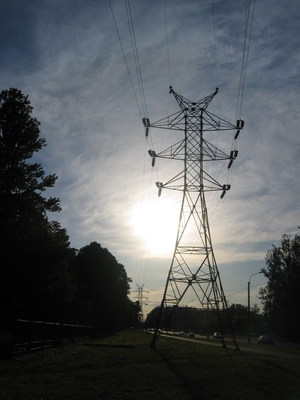Just what lies behind the electric bill? Just your electric usage? No, actually far more than that. To begin investigating I pulled out my paper bill and took a look at what exactly they were charging me for. I recommend that you pull out your power bill and do some similar examining.The charges on my bill:
Energy charge
This is the metered electric usage multiplied by the per kilowatt-hour (KWH) charge. Or to put it another way, it is just how much energy I use in a month. This part of my bill is 100% changeable based on my actions. Use less, pay less. Use more, pay more.
Energy customer charge
This fee pays for all the maintenance and infrastructure needed by my power company. The charge is the same for all customers and does not vary with electric usage. Thus, my actions have no effect on this part of the bill.
Clean air rider
This covers bond payments for the emission reduction project, a series of modifications to one of the local power plants. This part of the bill varies with my electric usage and also varies based on how well the company is doing paying off its debts. So I have some control over this part of my bill.
Power supply adjustment
This charge only appears when the cost to supply customers with power exceeds expectations. This could be due to high fuel costs, higher market pricing for electricity or something else. This fee does vary with electric usage, but it’s hard to predict when it will kick in.
City and state taxes
These ensure that the government gets its cut. The taxes are partially linked to my electric usage.What else is there?
Having examined the charges I proceeded to look over the rest of the bill to see what other information I could glean and discovered that my bill included a few interesting and potentially useful pieces of information. Such as the average daily KWH usage for this month compared to the same month last year. The bill also includes a bar chart showing changes in my energy use over 13 months. Pretty clearly shows that the months of July to September (otherwise known as summer) are my biggest months for power consumption. One really useful aspect of this chart is that it includes the energy usage regardless of who lived there. So if you have just moved in you can use usage patterns of the previous occupant as a basis for predicting your bill.
Moving on with my investigation I reached the end of the bill, the billing options. Pretty much the usual suspects: check, credit card, online billing to bank account or credit card.
There is also something called budget billing which works like this. The company takes an average of your previous bills and then calculates a single amount to charge you per month. This is designed to avoid summer or winter spikes your bill as you use more power to heat and cool your home. However, despite the company’s claims to the contrary, I can’t help but think you may lose money on this if your actual usage is lower than their average.
Having finished with the bill, I decided to poke around the website to see what else I could find. I’m willing to bet that your power company has a website with a similar set of goodies. First there are a large number of ways for you to save money. There are rebates and promotions for energy efficient appliances and light bulbs. They offer tips about how to save electricity and even have a monthly newsletter. Plus they have calculators for determining the energy usage and carbon footprint of appliances and heating and cooling systems. Finally, they offer services to help you assess how energy efficient your house is. Of course, they charge for these. Personally, I’m not so sure that they are worth the money.
One interesting thing I discovered was the power company offers energy assistance programs for people who use electricity to heat their homes during winter and can not afford it. If you are having trouble paying your electric bills you should contact your power company and see if they have a similar program.
One slightly disturbing program offered involves installing kill switches that allow the power company to turn off your air conditioning or electric water heater during peak times. For air conditioning the peak times are reported to be May 1st to September 30th. The power company claims that they only cut air conditioning for 7.5-11.5 minutes per 30 minutes. But report cuts of up to 24 minutes per 30. For the electric water heater they can turn it off all year and report that it may be off for 54 out of every 60 minutes. In return for allowing the power company to control your appliances you get credits on your bill. Personally, I would never go for this option. I don’t like giving control to other people. If I wanted to shut my air conditioning off, I’d turn it off my self!



